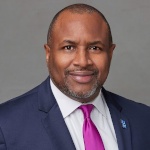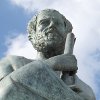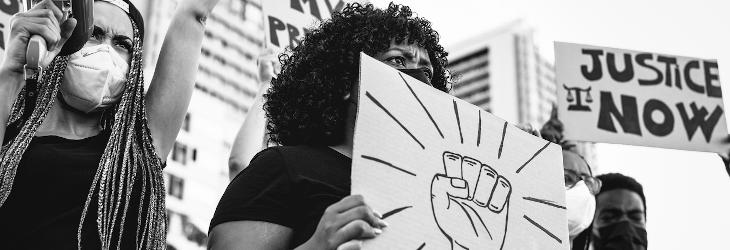Up until the middle of the 20th century, rhetorical scholars focused almost exclusively on the persuasive speech of powerful elites (Jensen 2004). The movements of the 1960s and 1970s, including the Civil Rights Movement, the popular opposition to the Vietnam War and many other “countercultural” movements, demonstrated the limitations to this focus. Some of the most important political rhetoric of the 20th century came from collective protests and the representatives of grassroots organizations. These movements (some more successfully than others) incited change from the political margins by employing novel visual and embodied protest tactics that could not effectively be described in the traditional rhetorical vocabulary. This challenged rhetoric’s focus on elites and individual orators while demonstrating the limits of the discipline’s emphasis on rational, verbal strategies of persuasion.
Rather than shy away from unfamiliar territory, the majority of scholars who study the rhetoric of social movements embrace the challenge of analyzing the unique tactics that marginalized and radical groups use to seek political change. While approaches to studying the rhetoric of social movements differ from one another, this subdiscipline is united by its interest in the forms of persuasion that movements use to inspire collective action and garner popular support for social, political, and economic transformations of the status quo.
Early Debates in Rhetoric of Social Movements
In 1952, when Leland Griffin published his foundational essay, “The Rhetoric of Historical Movements,” critics had already begun calling for rhetoric to expand its focus beyond individual orators and consider the different forms of public address employed by many different types of speakers. Responding to these calls, Griffin points to movements as an example of an important but underexplored topic in rhetorical criticism that is omitted by the focus on the rational arguments of individual speakers, and outlines how students of rhetoric might engage with them.
While Griffin’s essay remains an important reference point in contemporary discussions of social movement, movements wouldn’t become a major interest of rhetorical studies until the 1960s. Over the next decade, as the rhetoric of social movements developed, there was considerable debate between rhetorical scholars over two related topics: what a social movement is, and what counts as its rhetorical characteristics.
The first debate hinges on how scholars might distinguish a social movement from, on the one hand, broader changes and developments in political culture, and, on the other hand, from specific political organizations, political parties, campaigns, and organizations. Roger Cathcart argues that movements have two defining characteristics. On one hand, they oppose the political status quo. On the other, they still ultimately seek political change by lobbying those in power (typically the government) to enact that change. This is what, in his view, distinguishes social movements from institutional political reforms (which do not oppose themselves against those in power) and revolutionary movements (which seek to completely overthrow the existing political order).
David Zarefsky (1980) has countered positions like these, arguing that they still struggle to distinguish social movements from political parties or political campaigns. In the end, though, any definition of a social movement that is too specific can be problematically limiting. What we call movements often include many different kinds of political actors, from members of the public, to political parties, to non-governmental organizations (NGOs). In Griffin’s (1952) early essay he offers a very inclusive definition of social movements. He recommends that movement scholars should focus, at least initially, on social movements that are briefer and smaller in scope (e.g., he would likely encourage scholars to begin with Occupy Wall Street rather than try to engage the whole of the Occupy movement). From smaller studies like these, he argues, we can develop a critical vocabulary that allows us to analyze more widespread and enduring shifts in political culture. Later critics like Herbert Simons (1980) take a similar position, encouraging rhetorical scholars to “cast the widest net” when considering what counts as social movement.
Most contemporary scholarship on social movements has come to accept, at least tacitly, Simon’s “wide net” approach to defining social movements. Current research is less interested in identifying one “correct” definition of social movements than in conducting in-depth research on the rhetoric of specific movements, analyzing the rhetoric of movements comparatively, and discussing how movement tactics change over time. Still, these early definitional debates are important for scholars because they help clarify the theoretical considerations behind how we conceptualize social movement rhetoric. Perhaps more importantly, these discussions demonstrate the complexity of social movements and their political contexts, where many different actors collaborate and compete to rhetorically influence the political status quo.
The second early debate considers what qualifies as a movement’s rhetoric. The rhetorical tradition’s focus on rational argumentation led some disgruntled commentators to wrinkle their noses at the idea of studying movement rhetoric. The political tactics of social movements are irrational, these critics argue, because their primary appeals are based in pathos (emotion or affect) at best, and, at worst, are coercive. The major critical response to these objections pointed out that social movements are composed by those actors for whom political dialogue within democratic channels is impossible. These objections stress that the point of movement studies is to understand what is unique in the rhetoric of politically marginalized groups.
Spotlight on Scholarship – Featured Scholars in the Rhetoric of Social Movements
Learn more about recent research that has been conducted in the field of social movement rhetoric, and discover prominent scholars’ work in this field to examine and advocate for social justice communication.
Dr. Karma Chavez is an Associate Professor and Chair of the Department of Mexican American and Latina/o Studies at the University of Texas at Austin. Additionally, she is a Core Faculty member of the Center for Women’s and Gender Studies and teaches courses in the Department of Communication Studies, the Department of Rhetoric and Writing, the Center for Mexican American Studies, and the LGBTQ Studies Program. Her research focuses on immigration and migrant justice movements, LGBTQ activism, and the relationships and coalitions between these movements. Her books, Queer Migration Politics: Activist Rhetoric and Coalitional Possibilities and Palestine on the Air, have both received wide acclaim. Her newest work, The Borders of AIDS: Race, Quarantine, and Resistance is forthcoming in 2021. In addition to being a scholar of political activism, Dr. Chavez is the definition of an activist scholar; The National Communication Association has awarded Dr. Chavez the Centennial Award for Social Engagement and the Lambda Award for LGBTQ Advocacy.

Dr. Dana Cloud is now Senior Lecturer at California State University, Long Beach and California State University, Fullerton, after a long and impactful career as a rhetorician and critical/cultural scholar. Dr. Cloud’s research focuses on LGBT+ and labor movements, with a broader interest in the critical analysis of culture. Her books include 2018’s Reality Bites: The Rhetorical Circulation of Truth Claims in US Political Culture and 2011’s We Are the Union: Democratic Unionism and Dissent and Boeing. Dr. Cloud’s approach to rhetorical analysis is heavily influenced by Marxist political theory and her political activism has put her on “blacklists” of radical scholars. Despite this backlash, Cloud has had a prosperous career as a professor, holding appointments as Full Professor and Director of Graduate Studies in the communication departments at the University of Texas and at Syracuse University. She has won countless awards for her scholarship, including from the National Communication Association and the Western Communication Association.

Dr. Lisa Corrigan is an influential scholar of civil rights communication and social justice rhetoric who is passionate about the role communication plays in building coalitions for social justice and fostering political accountability in the face of racial and gender discrimination and stereotyping. She is the author of the award-winning book Prison Power: How Prison Influenced the Movement for Black Liberation, and her recent book Black Feelings: Race and Affect in the Long Sixties was published in 2020 to scholarly acclaim. She is also the co-founder and co-host of the popular podcast Lean Back: Critical Feminist Conversations, with Laura Weiderhaft.

Dr. James Darsey is a Professor Emeritus of Communication at Georgia State University, who has produced some of the most influential studies of LGBT activist rhetoric in the discipline. The National Communication Association honored his 1997 book, The Prophetic Tradition and Radical Rhetoric in America, with both The Diamond Anniversary Book Award and the Winana/Wichelns Award for Scholarship in Rhetoric and Public Address. In addition to his post at GSU, Dr. Darsey often serves as a guest lecturer at other universities, has served as director of the NCA research board, and organizes the Southern Colloquium on Rhetoric, which is dedicated to fostering professional development and intellectual exchange between rhetorical faculty members at southeastern universities.

Dr. Kevin Deluca is Professor of Communication at The University of Utah, where he also serves as a Hinckley Fellow at the Hinckley Institute of Politics and adjunct faculty in the Environmental Humanities Graduate Program and the Asian Studies Program. Dr. Deluca’s research focuses on the relationship between media technologies and forms of social activism. His research explores the politics of environmental activism, such as in his 1999 book, Image Politics: The New Rhetoric of Environmental Activism, as well as the Occupy movement and other progressive social movements. With Jennifer Peeples, he introduced and popularized the concept of the “public screen” to describe how social movements rhetorically employed media to capture publicity. Dr. Deluca’s scholarship is perhaps most notable for its innovative engagement with contemporary media and the variety of different movements he studies.

Dr. Andre E. Johnson is an Associate Professor at the University of Memphis in the Department of Communication and Film. Bringing together perspectives from media studies, rhetoric, and the study of popular culture, Dr. Johnson is a leading scholar of African American public address and the rhetoric of race and religion, as well as an influential voice in Hip Hop Studies. His research on social movements includes archival and critical work on the oratory of Henry McNeal Turner, as well as research on the contemporary Black Lives Matter movement. His book on the former, The Forgotten Prophet: Bishop Henry McNeal Turner and the African American Prophetic Tradition won the National Communication Association’s Outstanding Book Award in the African American Communication and Culture Division. In 2018, his co-authored book with Amanda Neil Edgar, The Struggle Over Black Lives and all Lives Matter, won the same award.

Dr. Darrel Wanzer-Serrano, who has also published under Darrel Enk-Wanzer, is an Associate Professor in Communication Studies at Texas A&M University where he also serves as a Core Faculty member in the Latino/a and Mexican America Studies Program. Dr. Wanzer-Serrano has taught at a number of acclaimed communication programs. His most recent appointment was at the University of Iowa, where he was an Associate Professor of Communication and the director of Latina/o/x Studies. Dr. Wanzer-Serrano’s movement research is primarily concerned with the Young Lords: a civil rights organization that Puerto Rican activist José Cha Cha Jiménez created in 1968 by organizing a Chicago gang. Wanzer-Serrano’s research focus on the Young Lord’s political and community-based actions in New York City. His book, The New York Young Lords and the Struggle for Liberation was published in 2015 and won NCA’s 2017 Book of the Year Award from the Critical/Cultural Studies Division and was nominated for numerous other honors.
Internal Strategies for Sustaining Social Movements, External Tactics of Public Persuasion
Despite these definitional disagreements, in practice rhetorical scholars mostly approach social movements in one of two ways, which are more complementary than contradictory. In what is mostly a matter of critical emphasis, some scholars engage the external tactics of social movements while others consider their internal strategies. External tactics describe the rhetoric a movement directs outward to persuade an audience, public, government etc., to support its cause. Internal strategies are the rhetoric that a movement directs toward its own membership to motivate, sustain, and direct their collective behavior.
The study of external tactics follows most closely in the footsteps of neo-Aristotelian rhetorical criticism, focusing on the persuasive or rhetorical strategies employed by the central orators involved in social movements. While staying close to the traditional rhetorical focus on important orators and speakers, this scholarship is not, as in the past, a study of political elites.
Moreover, many scholars of the external tactics of social movements go further and undertake the more novel task of investigating examples of movement rhetoric that work beyond speech, through the visual and embodied rhetoric of protests.
Robert Hariman and John Louis Lucaites (2001) point out the significance of visual rhetoric to protest movements by discussing the “iconic photograph” of a young woman weeping over her fallen classmate after National Guard Troops fired on peaceful demonstrators at Kent State University in 1970. The authors argue that the visceral emotional appeal of the photograph was vital to creating a feeling of identification between members of the public that bolstered opposition to the Vietnam War and increased national sympathy toward the protest movement.
Similarly, as Christine Harold and Kevin Deluca (2005) argue, the photograph of Emmett Till’s body that circulated through the media, particularly in the Black press, worked to mobilize the African American community at the start of the Civil Rights Movement and continues to have political reverberations in contemporary struggles for racial justice. Others have noted the importance of the embodied element of protest movements, emphasizing how protestors use their bodies to create physical disruptions that attract public visibility to their causes and address their rhetorical audiences with a physical presence that makes impersonal disengagement difficult (Deluca 1997, Foster 2003).
Alternatively, as Charles Stewart argues, internal strategies are the rhetorical appeals that a movement directs at its membership and base of support (Stewart 1991). Scholars who analyze movement rhetoric often take a “functionalist view” of movement rhetoric; they interpret rhetoric as a vitally important element sustaining the larger system of the movement (Stewart, 1980). Internal strategies are important to a movement’s cohesion, momentum, and political efficacy, especially as the movement meets resistance and the original political situation that catalyzed the movement shifts over time. For example, Stewart, in his introductory text on social movements written with Craig Allen Smith and Roger Denton (2012), explores how rhetoric mediates the organizational and group dynamics of social movements, mapping out the different types of rhetoric that fulfill separate strategic functions at each stage of a social movement’s development, from its genesis to its termination.
As noted above, these two approaches to analyzing social movements are more complementary than contradictory. Confrontational rhetoric directed at a movement’s opponents often works as a rhetorical appeal to that movement’s membership more than an appeal to the party addressed (Gregg 1971, Cathcart 1980). Further, as Karma Chavez (2011) argues, many movements use rhetorical strategies to build coalitions with other movements that share similar goals. Rhetoric of this kind has both internal and external factors to consider. In light of this, many scholars take hybrid approaches that consider both the external and internal consequences of the movement’s rhetoric.
The Rhetoric of Social Movements Today
As discussed, the prominent movements of the ‘60s and ‘70s galvanized scholarship on the rhetoric of social movements. Rhetorical movement scholarship has, since the outset, developed in step with the collective actors it studies. Scholars have now productively investigated a wide variety of social movements including the Women’s Suffrage Movement (Campbell 2002), the Civil Rights Movement, The Black Power Movement (Stewart 1997, Terrill, 2001), HIV/AIDS Activism in the 1980s and 1990s (Christian and Hanson 1996; Deluca 1999) LGBT+ rights movements, feminist movements (Soward and Rengar 2004), the Occupy movement (Deluca and Peeples 2002), and Black Lives Matter (A. Johnson 2018), to name only a few.
Other scholars explore the rhetoric of movements that are — returning to Griffin’s phrase — briefer and less well-known. For instance, Darrel Wanzer-Serrano (2006) analyzes the Young Lord’s role in mobilizing community action during the 1969 New York City Garbage Strike. There is also, of course, literature that considers movements outside the United States. As a subdiscipline, however, rhetoric of movements does have a definite US emphasis. Studies of international extremist movements have been investigated by interdisciplinary scholars of radicalization or terrorism far more frequently.
Each political movement and period has its own dedicated scholars, though not all movement scholarship is historically specialized. Some scholars investigate historical social movements; others engage with movements that are still in progress; others do more general or comparative research. While some scholars have pointed to difficulties with approaching ongoing movements, many social movements last for generations. It seems such movements must be considered in the present. Indeed, critical engagements with current movements have a greater potential to make a positive political impact, whether by identifying tactical tools for assisting in a movement’s development or deterring or constraining that development, which is increasingly important in the age of extreme right and white supremacist movements.
New Social Movements, Media Technologies, and Extremist Movements
The 2000’s occasioned a critical shift to study the “new social movements” that were emerging across the globe. These movements are primarily distinguished from previous movements by their use of digital technology, which allows for organization across political and geographic boundaries. As the social movements of the 20th century called upon rhetoricians to consider the role of the visual and embodied rhetoric of protest, the social movements of the early 21st century generated interest in how new media technologies and social networks transformed movement rhetoric.
These movements make heavy use of digital media for organizational purposes as well as a means of public address (i.e., internal tactics and external strategies). 20th century scholars of social movements, and members of the movements they studied, were highly aware that media technologies were a vital part of the success of a movement. Indeed, the visual and body rhetoric of the Civil Rights Movement was tactically effective in large part because it captured the attention of the news media. Controlling the “public screen” allowed the Civil Rights movement to make the violent injustice of the period hyper visible. In turn, it helped generate more popular support for calls for political change (Deluca and Peeples 2001, D. Johnson 2007).
The key difference between the so-called “new social movements” and these preceding periods of protest is not the rhetorical application of media technologies, but the novel modes of communication, organization, and collective action that new networked communications technologies and digital media afford. The Arab Spring generated a great deal of enthusiastic scholarly attention because social media had seemingly allowed for public mobilization for democracy to be organized despite government censorship (Markham 2014). Since, many critics have turned to analyzing how social media and digital technology are employed by social movements and, in turn, how these new technologies have impacted the nature of movements.
As the Black Lives Matter movement in the United States helps illustrate, the features of digital technologies are rhetorical; down to mechanics like hashtags, new media has become a central influence on new forms of collective action (Woods and McVey 2016). It is hard to imagine the global reach of the Occupy movement, Black Lives Matter, or the international solidarity protests following the police killing of George Floyd without the social connectivity afforded by digital technologies.
Though progressive movements have historically been the most popular subjects of rhetorical criticism, social movements mobilize around all sorts of different political ideologies. Over the last decade, scholars have become increasingly interested in white supremacist and far-right extremist movements that have gained a considerable foothold in the United States, Western and Eastern Europe, India, and elsewhere. The persuasive rhetoric of terrorist groups, as well as the rhetorical manipulation of online media by extremists have become crucial topics for rhetorical analysis. The rhetoric of these movements is often a far-cry from the rational, persuasive appeals favored by the rhetorical tradition, but there is a growing need to understand how extremist groups win political support within democracies as well as other systems of government.
If research on the rhetoric of social movements instigated a great deal of internal disagreement, this scholarship has proved very adaptable, and is now poised to become one of the most important areas of future rhetorical scholarship. As political marginalized groups and extremist groups both seek political change through similar protest strategies, a deep look into these strategies and how they work to persuade the public is absolutely crucial.
Sources and Additional Resources
For further reading on rhetoric and social movements, search for essays in The Quarterly Journal of Speech, Communication and Critical/Cultural Studies, Rhetoric and Public Affairs, and The Journal of Contemporary Rhetoric.
- Campbell, Karlyn Kohrs. 2002. “Consciousness‐raising: Linking Theory, Criticism, and Practice.” Rhetoric Society Quarterly 32(1): 45–64.
- Cathcart, Robert S. 1978. “Movements: Confrontation as Rhetorical Form.” Southern Speech Communication Journal 43(3): 233–47.
- Chávez, Karma R. 2011. “Counter-Public Enclaves and Understanding the Function of Rhetoric in Social Movement Coalition-Building.” Communication Quarterly 59(1): 1–18.
- Christiansen, Adrienne E., and Jeremy J. Hanson. 1996. “Comedy as Cure for Tragedy: Act up and the Rhetoric of Aids.” Quarterly Journal of Speech 82(2): 157–70.
- Darsey, James. 1991. “From ‘Gay Is Good’ to the Scourge of AIDS: The Evolution of Gay Liberation Rhetoric, 1977‐1990.” Communication Studies 42(1): 43–66.
- DeLuca, Kevin Michael. 1999. “Unruly Arguments: The Body Rhetoric of Earth First!, Act Up, and Queer Nation.” Argumentation and Advocacy 36(1): 9–21.
- Enck-Wanzer, D. (2006). “Trashing the system: Social movement, intersectional rhetoric, and collective agency in the Young Lords Organization’s garbage offensive.” Quarterly Journal of Speech, 92(2), 174-201.
- Foster, Susan Leigh. 2003. “Choreographies of Protest,” Theatre Journal 55: 395-412.
- Gregg, Richard. 1980. “The Ego-Function of Protest,” Philosophy & Rhetoric: 71-91.
- Griffin, Leland M. 1952. “The Rhetoric of Historical Movements.” Quarterly Journal of Speech 38(2): 184–88.
- Hariman, Robert, and John Louis Lucaites. 2001. “Dissent and Emotional Management in a Liberal‐democratic Society: The Kent State Iconic Photograph.” Rhetoric Society Quarterly 31(3): 5–31.
- Harold, Christine, and Kevin Michael DeLuca. 2005. “Behold the Corpse: Violent Images and the Case of Emmett Till.” Rhetoric and Public Affairs, 8(2): 263–86.
- Jensen, Richard J. 2006. “Analyzing Social Movement Rhetoric.” Rhetoric Review, 25 (4): 372-375.
- Johnson, Davi. 2007. “Martin Luther King Jr.’s 1963 Birmingham Campaign as Image Event.” Rhetoric and Public Affairs 10(1): 1–25.
- Johnson, Andre E. “Dislocations and Shutdowns: MLK, BLM and the Rhetoric of Confrontation.” Journal Of Contemporary Rhetoric.
- Markham, Tim. 2014. “Social Media, Protest Cultures and Political Subjectivities of the Arab Spring.” Media, Culture & Society 36(1): 89–104.
- Michael DeLuca, Kevin, and Jennifer Peeples. 2002. “From Public Sphere to Public Screen: Democracy, Activism, and the ‘Violence’ of Seattle.” Critical Studies in Media Communication 19(2): 125–51.
- Sillars, Malcolm O. 1980. “Defining Movements Rhetorically: Casting the Widest Net.” Southern Speech Communication Journal 46(1): 17–32.
- Simons, Herbert W. 1970. “Requirements, Problems, and Strategies: A Theory of Persuasion for Social Movements.” Quarterly Journal of Speech 56(1): 1–11.
- Sowards, Stacey K., and Valerie R. Renegar. 2004. “The Rhetorical Functions of Consciousness‐raising in Third Wave Feminism.” Communication Studies 55(4): 535–52.
- Stewart, Charles J. 1980. “A Functional Approach to the Rhetoric of Social Movements.” Central States Speech Journal 31(4): 298–305.
- Stewart, Charles J., “The Evolution of a Revolution: Stokely Carmichael and the Rhetoric of Black Power,” Quarterly Journal of Speech, 83 (1997), pp. 429-446.
- Stewart, Chales J, Smith, Craig Allen Smith, & Roger Denton (2012). Persuasion and Social Movements. Waveland Press.
- Stewart, Chales J. 1991. “The Internal Rhetoric of the Knights of Labor.” Communication Studies 42(1): 67–82.
- Terrill, Robert. 2001. “Protest, Prophecy and Prudence in the Rhetoric of Malcolm X,” Rhetoric & Public Affairs, 4: p. 25-53.
- Woods, Heather and James Alex McVey. 2016. “# BlackLivesMatter as A Case Study in the Politics of Digital Media: Algorithms, Hashtag Publics, and Organizing Protest Online. Teaching Media Quarterly,” 4(1): 1-9.
- Zarefsky, David. 1980 “A Skeptical View of Movement Studies.” Communication Studies 31 (4): 245-254
Additional Topics on Research in Rhetorical Studies

This guide provides an in-depth discussion of rhetorical studies, describing the history and significance of the discipline while also providing readers with theories that are useful to understanding different forms of rhetoric and their functions in human communication.

This article discusses the field of critical rhetoric and its importance in the examination and exposure of power dynamics in society. It also provides information on key scholars in the field who study how rhetoric connects to equality, politics, and cultural values.

This detailed article discusses the history and forms of gender criticism in rhetorical studies, and also explains the political, social, and cultural significance of this field of study.

This article provides an overview of genre criticism in rhetorical studies, and how it has evolved over the centuries. It also explains the influential work of scholars in this field of study.

This article explores scholarly approaches to understanding persuasion as material. Explore how scholars have attempted to understand rhetorical discourse as a material thing, and, on the other hand, how material things, like monuments and roads, can be politically persuasive.

This article explains how metaphors are widely used in human communication and understanding, and provides a background on the history and prominent scholarship of this field.

This article covers narrative criticism and the role it plays in culture, politics, and relationships, while also providing examples of prominent scholarship in this field.


